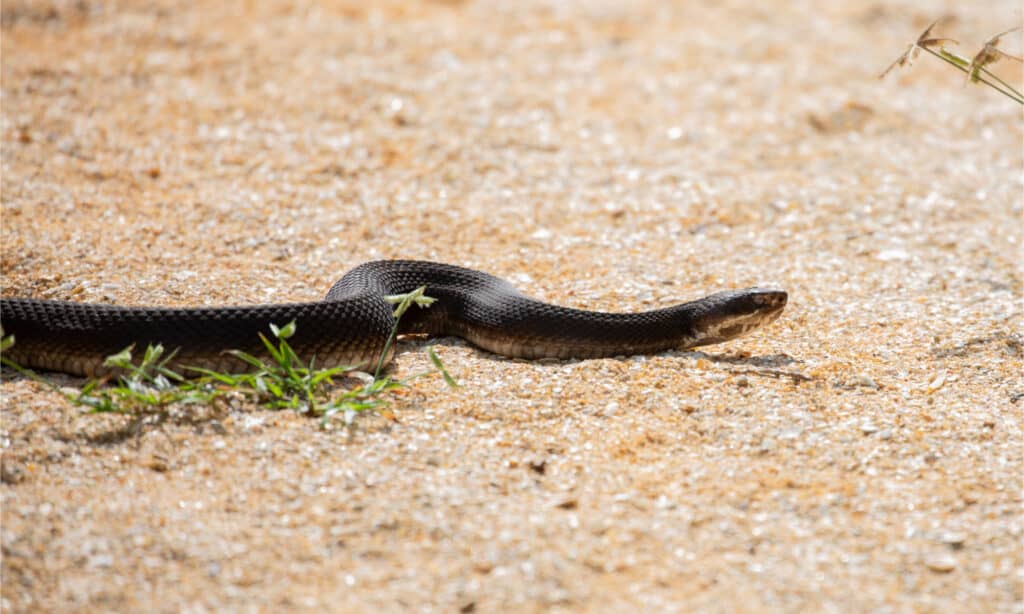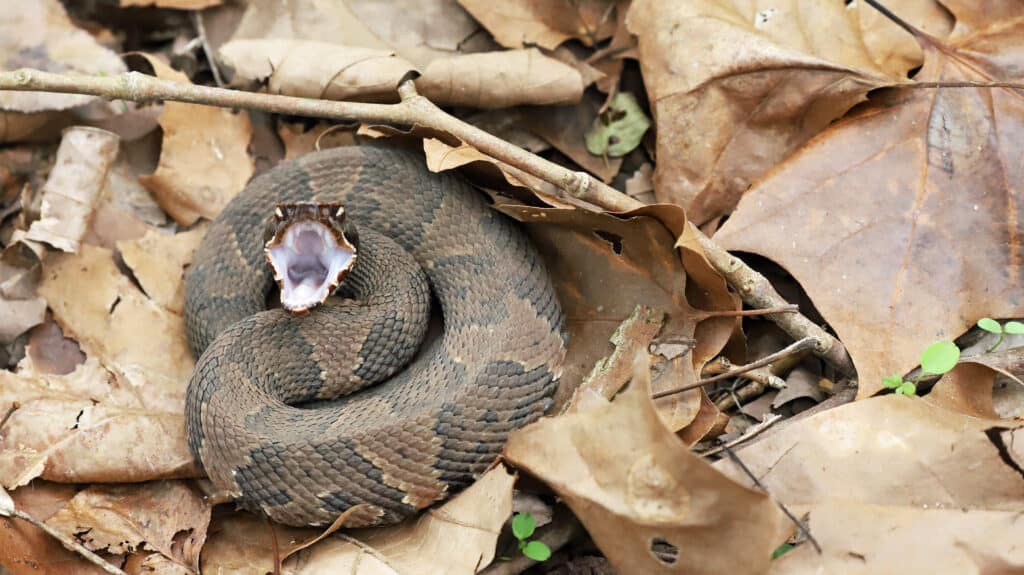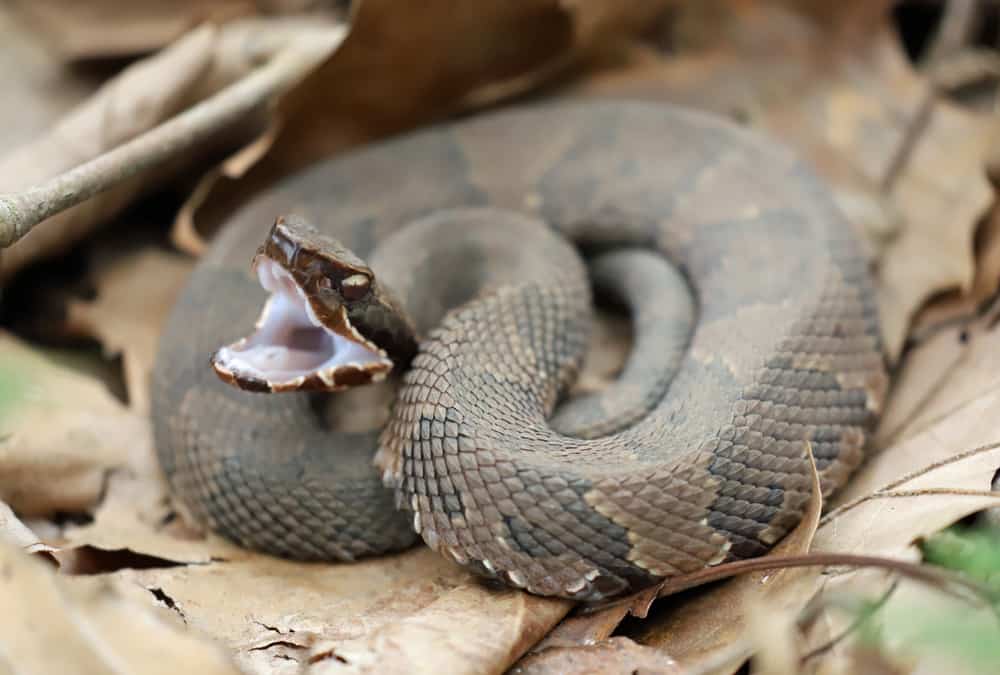Snakes are incredibly interesting and diverse creatures. In fact, there are over 3,500 species around the world except in Antarctica, New Zealand, Greenland, Iceland, and Ireland. In the United States alone there are around 50 different species! This article will explore two closely related snake species that are both living in the United States– the Florida cottonmouth and the northern cottonmouth. How are they related? Where do they live? Which is more dangerous? Let’s find out!
How are Florida Cottonmouths and Northern Cottonmouths Related?

A northern cottonmouth sunning on a sandy path near the saltwater marsh on the Tolomato River.
©Linda Burek/Shutterstock.com
In short, the Florida cottonmouth and northern cottonmouth are two different species. In 2015, scientists first recognized the Florida cottonmouth as a distinct species based on molecular data.
All snakes belong to the suborder Serpentes. This suborder falls within the class Reptilia, and within the largest order of reptiles, Squamata. Squamata, from the Latin squamatus meaning having scales, also includes other scaly reptiles such as lizards and amphisbaenians (worm lizards).
The Florida cottonmouth and northern cottonmouth are both species of vipers belonging to the family Viperidae. Other families of snakes include pythons, boas, blind snakes, elapids, typical snakes, and more. Vipers are a family of venomous snakes that have a wide distribution around the world. Vipers are unique because some species give live birth rather than laying eggs like most snakes.
Within the family Viperidae, the Florida and northern cottonmouth both belong to the genus Agkistrodon. This genus includes 8 species of pit vipers commonly referred to as American moccasins and is endemic to North America. This means that species in this genus only exist in North America. To learn more about cottonmouth species, click here!
Where Do Florida and Northern Cottonmouths Live?

The Suwanee river in White Springs Florida, a blackwater river flowing out of the Okefenokee Swamp in southern Georgia, USA.
©Nolichuckyjake/Shutterstock.com
The Florida cottonmouth inhabits the southeast United States primarily throughout the Floridian peninsula and Florida Keys. In fact, many snakes live in this area! You can also find them in southern Georgia and in smaller populations in other nearby states. This snake most often resides in swampy habitats, thickets along ponds, and other wooded edges along bodies of water.
The Northern cottonmouth also lives in the southeastern United States in Virginia, Florida, Georgia, Oklahoma, Arkansas, South Carolina, North Carolina, Tennessee, and Texas. Similar to the Florida cottonmouth, the Northern cottonmouth also prefers swampy habitats, including the Great Dismal Swamp in southeast Virginia.
There are geographic regions where these species coexist, and some areas may be hybridization zones. A hybridization zone is a location where both species exist and interbreed to form a hybrid species. The exact locations and extent that these two species integrate is not certain, however, interbreeding and hybridization may occur from North Carolina to southeastern Louisiana. To learn more about where different cottonmouth species live, click here! To learn about hybridization with copperhead snakes, click here!
How are Cottonmouths Different than Other Snakes?
Venom

A cottonmouth poised to strike.
©KF2017/Shutterstock.com
Like all vipers, but not like all snakes, the Florida and northern cottonmouths are venomous. Venom is a trait that exists in a diverse array of animals and plants. Often, shared traits amongst different species can indicate a common ancestor that the trait was retained from across evolutionary time. For example, all mammals have mammary glands so they can breastfeed their young. This trait didn’t evolve separately in elephants and humans, the trait was retained in both species from a shared mammalian ancestor.
This is not the case with venomous organisms. Unlike lactation, venom evolved separately in many species that were facing similar evolutionary pressures; this is called convergent evolution. Another example of convergent evolution is the North American Cactus and the African Euphorbia. Both are succulent plants with pointy spines that look remarkably similar, however, they are not closely related. They both evolved these spines separately in response to similar environmental pressures and did not retain the trait from a shared ancestor.
Semiaquatic Viper

Cottonmouths are considered to be one of the few semiaquatic snakes in the world.
©jo Crebbin/Shutterstock.com
The Florida and northern cottonmouths are also unique because they are two species of the few semiaquatic vipers worldwide. Being semiaquatic implies that they spend a substantial amount of their life in the water and rely on it for their survival in some way. These two cottonmouth species rely greatly on the marshy, swampy habitats they live in; however, the Florida cottonmouth is not entirely dependent on water and can occasionally be found up to a mile away from surface water.
How are Florida Cottonmouths Different than Northern Cottonmouths?

Florida Cottonmouth, also known as a water moccasin snake, close up.
©iStock.com/Saddako
The northern cottonmouth and Florida cottonmouth have several striking similarities, but how are they different? First of all, you can identify them and tell them apart based on physical characteristics. Florida cottonmouths have black vertical lines at the tip of their snouts whereas Northern cottonmouths do not. Also, Florida cottonmouths typically have lighter color patterns with clearer definition on their heads than the Northern cottonmouths. On average, the Florida cottonmouths also have longer tails.
Second of all, the Northern cottonmouth has a much greater geographic range than the Florida cottonmouth. The Florida cottonmouth is relatively contained to Florida and parts of Georgia, whereas the Northern cottonmouth inhabits many surrounding southeastern states as well.
Third of all, although both snakes are venomous, their venom operates differently and has differing health consequences. The Florida cottonmouth secretes venom that affects the prey’s or victim’s red blood cells, whereas the Northern cottonmouth’s venom causes tissue death. The danger of these venoms is described further in the next section.
Which Cottonmouth is More Dangerous?

This warning sign alerts people of poisonous snake populations in the area.
©Jeff W. Jarrett/Shutterstock.com
The Florida cottonmouth’s venom is highly hemolytic, meaning it causes red blood cells to burst. Bites from a Florida cottonmouth have been reported to have a higher mortality rate. The northern cottonmouth produces a venom that acts as a cytotoxin that destroys tissue. This can lead to scarring and occasionally can require amputation, but rarely causes death. From a mortality standpoint, the Florida cottonmouth is more lethal. Between 7,000 and 8,000 people are bitten by venomous snakes every year, but less than 1% are cottonmouth bites. To read more about cottonmouth bites, click here.
How are Florida Cottonmouths and Northern Cottonmouths Doing Today?

You can recognize cottonmouth snakes easily because of their distinctly white mouths.
©KF2017/Shutterstock.com
The International Union for Conservation of Nature (IUCN) Red List tracks the statuses of animals and plants in the wild and determines their level of endangerment. This allows conservationists to identify vulnerable species and direct resources to where the situation is most desperate. The classification categories in order of increasing severity are data deficient, least concern, near threatened, vulnerable, endangered, critically endangered, extinct in the wild, and extinct. The Florida cottonmouth and northern cottonmouth snakes both have the classification of least concern which indicates that no intervention is necessary, and their populations are stable.
The photo featured at the top of this post is © KF2017/Shutterstock.com
Discover the "Monster" Snake 5X Bigger than an Anaconda
Every day A-Z Animals sends out some of the most incredible facts in the world from our free newsletter. Want to discover the 10 most beautiful snakes in the world, a "snake island" where you're never more than 3 feet from danger, or a "monster" snake 5X larger than an anaconda? Then sign up right now and you'll start receiving our daily newsletter absolutely free.
Thank you for reading! Have some feedback for us? Contact the AZ Animals editorial team.






